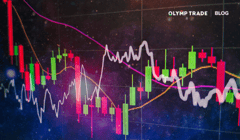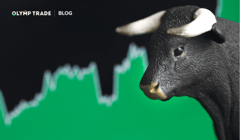
This week’s digest explains the factors behind the US stock market’s decline and the massive interest rate increase done by several central banks. Check it out!
Interact with the dashed blue word and green spot on images to get additional details and explanations.
More details on the visuals will be here.
A term definition or explanation will be here.
Contents
Weekly Trends
NASDAQ ↓ -3.03%
Trading down with a $100 and an X100 multiplier on Forex Olymp Trade, you could have easily made $303.00.
Brent ↑ 8.22%
Trading up with a $100 and an X50 multiplier on Forex Olymp Trade, you could have easily made $411.00.
GBP/JPY ↑ 1.72%
Trading up with a $100 and an X500 multiplier on Forex Olymp Trade, you could have easily made $860.00.
Currency Markets
Interest Rate Hikes, Growing Inflation, and the Corporate Earnings
USD is gaining value against most currencies. This growth is supported by the investors’ expectations of the interest rate increase and their demand for the USD as a safe-haven currency with the Russia-Ukraine conflict in the background. A week-long growth in energy prices boosted inflation and fueled the USD’s growth, too.

In the US, growing inflationary pressures keep pushing up the import and export prices. The March PPI was reported to be 1.4%, which is the highest since 2012. Retail sales grew by 1.1% and consumer sentiment came out at 65.7, the highest in four months. These dynamics mean that the decline of confidence in the economy has started to stabilize.
The Federal Reserve has spoken about increasing the interest rate at each of the interest rate decision meetings this year. While this plan is expected to halt the rising inflation, it may hurt exporters' interests by boosting the USD against other currencies, especially EUR. Therefore, opening sell positions with the EUR/USD may be a trade idea to consider. We believe it may be best to enter the market after a pullback on the daily graph below.

Sell trade entry - 1.0862
Buy on Rumors, Sell on the News
If an event’s potential impact has already been factored in by the market, the instrument price can behave in an unexpected manner. This week, several central banks raised their interest rates by 50 basis points. This comes after similar steps previously taken by the US Fed. Last week, the Reserve Bank of New Zealand and Bank of Canada both raised rates by the same 50 basis points.
The nature of financial markets is speculative as they always look forward. This means that the market participants adapt to changing situations and open positions according to their future expectations. When the news is out, positions are unwound, and prices often behave counterintuitively. That is because if a particular news release had been anticipated by the market long before, most price movement in reaction to that expectation happens before the actual news release. After the release, most positions get closed or reversed to capitalize on the pullback.
For example, the Bank of Canada raised the interest rate to 1.00% and announced it would start its balance sheet reduction this month. This move follows the bank’s months-long rhetoric, aligned with the Federal Reserve and the Reserve Bank of New Zealand. Although CAD did not drop sharply after the announcement like the NZD did in reaction to its bank’s news, its growth was halted. In the GBP/CAD chart, we see a “head and shoulders” reversal pattern forming. If the resistance level is broken, GBP may strengthen against CAD.

Price target, 1.6567$
In the meantime, the European Central Bank decided not to raise interest rates. We do not believe they will be able to keep this policy line for long because inflation in Europe is at record highs. In March, it reached 7.5%. In keeping the rate unchanged, the ECB is deviating from the policy of the US, UK, New Zealand, Australian, and Canadian central banks. The Bank of Japan, Swiss National Bank, and the ECB are the last banks to keep rates flat in the face of rising inflation. Rising volatility in the Forex markets is getting close to historical highs. It offers traders trend-following profit opportunities and gives more room to work with deeper corrections.

Stock Markets
US Markets Fell During the Week
The US stock market has mostly been going down last week. The Russia-Ukraine crisis keeps affecting financial markets. Besides the rising energy prices, food supply disruptions may particularly hit developing countries. In the meantime, the earnings season has started, and the JPMorgan Chase, Goldman Sachs, and Morgan Stanley investment banks have shared their performance first as always. While their quarterly revenues were reported to be almost half the size of the first quarter in 2021, the Earnings per share are at the lower levels over the last 5 quarters. That indicates that this earnings season may mostly bring weak corporate performance results.

The above heat map shows that many sectors are not doing well at the start of the earnings season. The S&P 500, NASDAQ and Dow Jones have all mostly been going down last week. The S&P appears to be particularly weak.

Price target, $4330.82
Worrying Indications of JPMorgan’s Report
While the bank’s performance raises questions, the CEO expects more troubles ahead. Last week, JPMorgan Chase, one of the top US banks, reported an EPS of $2.63 vs a forecast of $2.69 and a 42% drop in profit down to 8.3$ bln. While these dynamics are worrying enough, CEO Jamie Dimon commented that the Russia-Ukraine crisis is a major problem for growth, apart from the slowing country dynamics and rising inflation. With the world’s supply and demand cycle under stress, the economic isolation of Russia currently sought by international powers may damage the world’s largest economies.

Price target, $123.50
The JPM stock price chart shows that the support level of 128.32 was broken and that the downtrend continued. During the market session that followed the day of the earnings report release, the stock dropped and broke the daily lows. The previous JPM report was weak, and the stock went down upon it. We believe it may behave in a similar manner this time. Therefore, the downtrend will likely continue towards the lower support level of 123.50.
Goldman Sachs and Morgan Stanley brought a similar outlook. Although Goldman Sachs beat expectations, those were previously set at extremely low levels. While the previous quarter’s EPS was $10.81, the EPS for the first quarter this year was only $10.76. Morgan Stanley reported an EPS of $2.06 against the last year’s EPS of $2.08 for the same period.
This week, IBM, Johnson & Johnson, and Netflix will report on April 4, and Procter & Gamble will report on April 20. We expect weak earnings from Netflix because the company is barely managing the competition from its main rivals, Amazon Prime, HBO Max, and Disney Plus. Last year, the company had its weakest increase in subscriber base since 2015. This quarter, the company’s expected 2.5 million new subscribers are well below the four million of the same period last year.
Commodity Markets
Geopolitical Uncertainty Keeps Pressing on the Commodity Markets
Gold breaks out of a flat. As of last week, tensions between Ukraine and Russia remained unchanged. In the meantime, central banks’ actions and the spreading coronavirus in China are affecting the commodity markets. Historically, there has been a negative correlation between interest rates and commodity prices, especially in major economies such as the US and Europe. Previously, the US Federal Reserve shared a hawkish outlook in the released FOMC Meeting Minutes. Over there, the Fed indicated a plan to raise the interest rate by approximately 170 basis points before the year ends. On the contrary, last week’s announcement by the European Central Bank made it clear that the bank was not planning to do the same. Instead, the ECB is planning to keep a cautious policy line while keeping the rate at 0%.
This week, global uncertainty pushed the gold price break out of the three-week-long range. During five sessions straight, it has been trading in an uptrend. It rose above the 38.2% Fibonacci retracement level and established itself at a new baseline level of $1,960. The next resistance level will be the 23.6% Fibo level around $2,000. The support level is at the 50% Fibo level at $1,925, and the midrange is 38.2% Fibo at $1,960.

Target $1,925
Target $1,960
Target $2,000
The Oil Market is Under Pressure
Brent failed to stay down under $100 even with the US Fed’s hawkish tones. Managing the rising inflation and unprecedented rise in energy costs because of the Russia-Ukraine conflict is a primary factor for the FOMC’s hawkish tone. Although extra supplies from the IEA and the interest rate hike helped keep the Brent price down, the effect was short-lived. On Monday last week, Brent dropped to $97.39. After the correction, the Three White Soldiers chart pattern was formed, and the price rose above $110 again. While a dip below $100 is possible, the resistance level is now at $120.

Target $120
Target $102
Cryptocurrency Markets
Crypto is Down, in Correlation with Stocks and Interest Rate Hikes
BTC and ETH dropped below key support levels. Just as the FOMC raised its views on the rate hike, stocks and cryptocurrencies went down. On Monday, Bitcoin and Ethereum dropped below the key support levels. Last weekend, the major Bitcoin conference ended with no new investors in sight, and that may fortify the crypto’s downward momentum in the near term.
The Fear and Greed index dropped to Extreme Fear, down to 22 points. The total cryptocurrency market capitalization is now down to $1.87T, below last week's $2.01T.

Good Moment to Buy Bitcoin
Now may be a good opportunity to buy BTC. Bitcoin is currently down at $40,000. We are now following the trend line support level from the end of January 2022. In times of turmoil, a drop to the trend’s support levels allows buying crypto assets at low levels. Keep up with the latest macroeconomics for crypto volatility as news continues to drive the markets.

Target $40,000
Target $42,208
Target $45,113
Target $50,000
Risk warning: The content of the article does not constitute investment advice and you are solely responsible for your trading activity and/or trading results.
A head and shoulders is a technical analysis chart formation that appears as a baseline with three peaks. The two on the outside are at similar levels and the one in the middle rises higher above. Usually, this chart formation is seen as bringing a trend reversal.
Earnings per share, or EPS, is calculated as a company's profit divided by the outstanding shares of its common stock. The resulting number serves as an indicator of a company's profitability.











